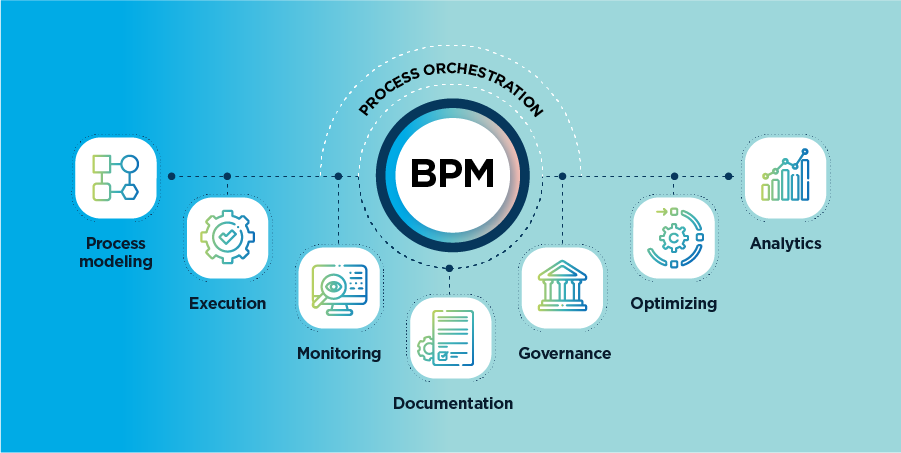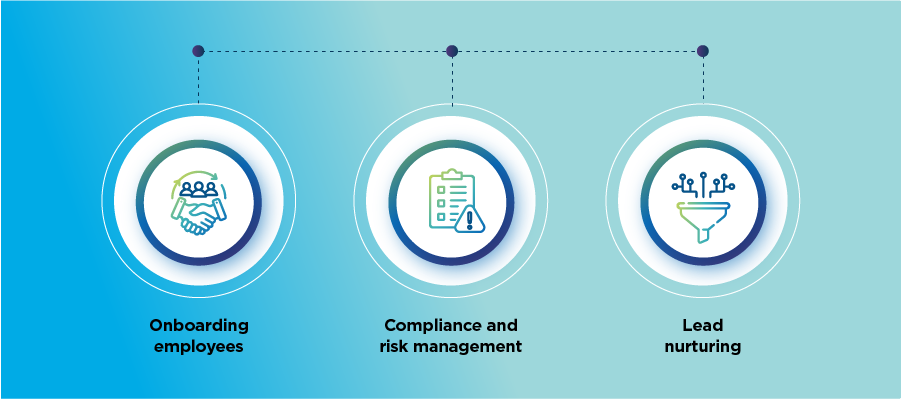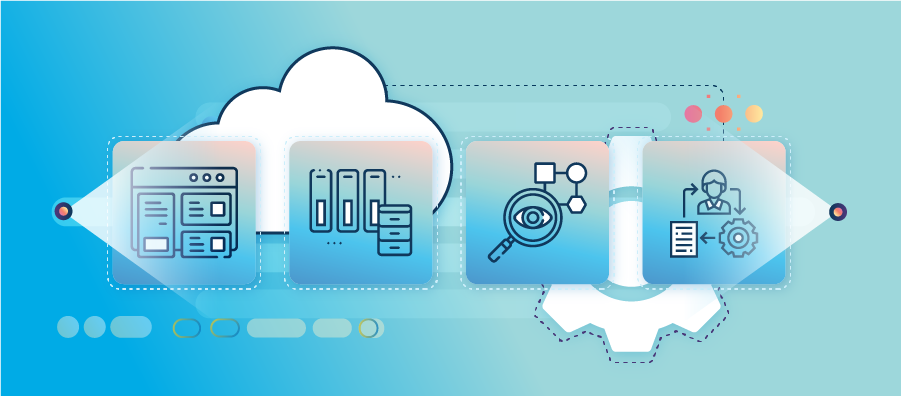Bringing Processes and People Together

Streamline Process with Business Process Orchestration
Most organizations actively seek ways to streamline their end-to-end business processes, but legacy systems, operational slowdowns and lack of communication hold many of them back from achieving their business outcomes. Meanwhile, business stakeholders are looking for solutions with a good return on investment (ROI).
Replacing old ways of working to achieve digital transformation can be costly if it’s not done with the right oversight. That’s where process orchestration comes in. Process orchestration gives you greater visibility and control over your entire workflow, and as an element of business process management (BPM), it makes automation easier to deploy, manage and optimize.
What Is Business Process Orchestration?
Business process orchestration software infuses collaboration tools that allow business users to design, manage and monitor business processes with the aim of orchestrating workflows across people, systems and technologies such as intelligent automation (IA). It provides a holistic view of how automated processes are performing.
In simpler terms, process orchestration solutions coordinate the cogs in the machine, ensuring everything is greased and running efficiently, with the end goal of letting the machine run itself – what we call ‘end-to-end’ business process automation (BPA).
An automated process removes repetitive tasks from employees so they can focus on higher-value initiatives. Adding in the extra layer of workflow management, any disparate processes can be brought together to create a more streamlined and cohesive end-to-end solution.
What’s the difference between business process management and process orchestration?

Process orchestration is a component of BPM. Orchestration doesn’t include form design or human interaction as BPM does, which is why it’s only a part of the larger BPM umbrella. Here’s how we break it down.
BPM includes process modeling, execution, monitoring, optimizing, governance, documentation and analytics. BPM expands beyond traditional automation tools to involve your human workforce in the decision-making process. The part of BPM that gets the automated components working together is the process orchestration tool.
Business process management software capabilities can include:
- Models of as-is processes
- Task mining and process mining
- Rules management
- Design user interfaces
- Data capturing
- Insights into process stages
- Real-time visibility
- Managing a human and digital workforce
Process Orchestration | Business Process Management (BPM) | Robotic Process Automation (RPA) | Intelligent Automation (IA) |
Connects automated processes into cohesive workflows | Connects people with automated processes | Automates tasks | Combines BPM, RPA and AI |
We’ve expanded the BPM umbrella a bit further with SS&C | Blue Prism® Chorus BPM. Chorus combines these leading technologies to help enterprises realize the full benefits of IA by allowing users to transform, manage and automate critical business processes. It’s a process design tool where you can create new model workflows or update existing ones easily, with a user-friendly interface including pre-built designs and drag-and-drop features that allow you to reduce the number of complex processes in your workflows.
Chorus brings together:
- Machine learning (ML)
- Automation tools
- Low-code and no-code process automation
- System integration
- Case management
- Multi-experience communications
- Business rules
- Omnichannel document intake
- Operational analytics
How does process orchestration differ from process automation?
Process orchestration takes a holistic approach, while process automation works on the level of individual processes or tasks. Both are useful and used together, they’re nearly unstoppable.
While process orchestration technology gives you visibility and control over how your automated processes are running, process automation automates processes. A subset of this is robotic process automation (RPA), which mimics human actions to automate tasks. In other words, process orchestration is your mission control center, and the automated tasks are your feet on the ground.
Automation focuses on the actions, whereas process orchestration focuses on unifying individual tasks into entire processes. This allows IT and Center of Excellence (CoE) teams to manage your process lifecycles from a central location and turn your endpoints into process models.
Within IA’s sphere are RPA, BPM and artificial intelligence (AI). The aim of process automation is to:
- Reduce human errors by automating areas rife with manual errors.
- Increase efficiency by speeding up processing time.
- Boost productivity by removing the need for human intervention.
- Improve employee satisfaction by reducing manual tasks and repetitive processes.
- Improve customer satisfaction by providing faster, more accurate customer service.
What Are Examples of Business Process Orchestration?

Okay, so we know simple task automation isn’t enough anymore. It’s about unifying processes to create a cohesive workflow with clear, auditable paths. Now, we’ll look at how you can apply process orchestration to your business with some use cases.
Onboarding employees
The hiring process can be a jumble of extensive paperwork, checking credential requirements, new account setups, equipment allocation and scheduling meetings. To streamline these interdependent processes, you’ll first bring in a digital worker to trigger automatic workflows, such as emailing a hiring notice to the HR and legal team, informing them of the start date, employment type, manager and so on. Once the new hire letter is delivered, the hiring manager is notified through the central BPM platform, along with any IT personnel needed to prepare the starting equipment.
Compliance and risk management
Compliance can be a tricky and time-consuming process. Process orchestration within a BPM platform allows you to document your processes following your industry-specific frameworks. You can assign your automated processes to run control tests, identify risks and flag them immediately. Since it’s all done in a unified platform, it’s easier to manage risk and ensure compliance.
Lead nurturing
A timely message can prove the difference when drawing in prospective customers. Lead nurturing tends to be repetitive in nature, with various branches that can be hard to track. That’s why orchestrating these processes is so useful. Automating your lead nurturing workflow and monitoring click behaviors can help guide you to data-driven decisions. You can see what works, what doesn’t and where you can improve – leading to more effective nurture campaigns in the future.
What Are The Benefits of Business Process Orchestration?

Before adopting a new technology, it’s important to consider your goals by establishing your key performance indicators (KPIs) and what automation investments you’d like to make. Your process KPIs could include cost savings, streamlining business operations or developing better customer relationships.
The benefits of process orchestration are wide-ranging, but let’s look at a few:
- Coordinates disparate systems and tools for cohesive processes.
- Reduces process complexity by connecting workflows.
- Improves time-to-value by removing bottlenecks and process siloes.
- Simplifies compliance by providing fully auditable reporting.
- Centralizes access in a single process orchestration platform.
- Provides a low-code/no-code approach so business teams can automate good processes quickly and easily.
- Uses pre-built connectors and automation templates to support third-party applications.
Creating a Firm Foundation
Your internal processes are your organization’s foundation, which is why it’s imperative to get those running at peak performance. However, manually documenting process steps to determine a better path isn’t always easy and can make for slow adaptability.
With the right automation platforms guiding your journey, backed by the user-friendly interface of a universal process orchestrator, your organization can streamline operations, enhance collaboration and bring together disparate systems and people.
To have flexible and robust business processes is no longer just a matter of automating manual tasks; it’s about expanding your view to orchestrating entire workflows and making it easier for your people, systems and digital workforce to interact and collaborate.
SS&C Blue Prism provides end-to-end solutions to fit your business needs. We’ll guide you along your automation journey – no matter where you’re at – to ensure you continuously meet your business outcomes.